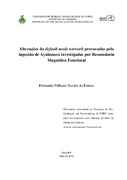Please use this identifier to cite or link to this item:
https://repositorio.ufrn.br/handle/123456789/17020| Title: | Alterações da default mode network provocadas pela ingestão de Ayahuasca investigadas por Ressonância Magnética Funcional |
| Authors: | Fontes, Fernanda Palhano Xavier de |
| Advisor: | Araújo, Dráulio Barros de |
| Keywords: | Ayahuasca;Default Mode Network;fMRI;conectividade funcional;Ayahuasca;Default Mode Network;fMRI;functional connectivity |
| Issue Date: | 25-May-2012 |
| Publisher: | Universidade Federal do Rio Grande do Norte |
| Citation: | FONTES, Fernanda Palhano Xavier de. Alterações da default mode network provocadas pela ingestão de Ayahuasca investigadas por Ressonância Magnética Funcional. 2012. 112 f. Dissertação (Mestrado em Neurobiologia Celular e Molecular; Neurobiologia de Sistemas e Cognição; Neurocomputação Neuroengen) - Universidade Federal do Rio Grande do Norte, Natal, 2012. |
| Portuguese Abstract: | A Ayahusca é uma bebida psicotrópica que tem sido utilizada há séculos por populações originais da América do Sul, notadamente da região Amazônica, com fins religiosos e medicinais. O chá é obtido pela decocção de folhas da Psychotria viridis com a casca e tronco de um arbusto, a Banisteriopsis caapi. A primeira é rica em N,N-dimetiltriptamina (DMT), que tem importante e bem conhecido efeito alucinógeno devido a sua atuação agonista nos receptores de serotonina, especificamente 5-HT2A. Por outro lado, as β-carbolinas presentes na B. caapi, particularmente a harmina e a harmalina, são potentes inibidores da monoamina oxidase (iMAO). Além disso, a tetrahidroharmina (THH), também presente na B. caapi, atua como leve inibidor seletivo da recaptação de serotonina e um fraco inibidor de MAO. Essa composição única provoca uma série de alterações afetivas, sensoriais, perceptuais e cognitivas em indivíduos sob o efeito da Ayahuasca. Por outro lado, existe um interesse crescente na rede de modo padrão, do inglês Default Mode Network (DMN), que tem sido consistentemente observada em estudos de neuroimagem funcional. As principais componentes dessa rede incluem estruturas da linha média do córtex cerebral, como o córtex frontomedial anterior, córtex frontomedial ventral, o giro cingulado posterior, o pré-cuneus e algumas regiões do lobo parietal inferior e do giro temporal médio. Acredita-se que a DMN participe de tarefas que envolvem autojulgamentos, evocação de memórias autobiográficas, realização de simulações mentais, pensar em perspectiva, estados meditativos, entre outros. De maneira geral, essas tarefas requerem um foco de atenção interno, daí a conclusão de que a DMN estaria associada à atividade mental introspectiva. Assim, este estudo teve como objetivo avaliar, por meio de ressonância magnética funcional (fMRI), as possíveis mudanças da DMN causadas pela ingestão da Ayahuasca em 10 voluntários saudáveis investigados enquanto se submeteram a dois protocolos: uma tarefa de fluência verbal e a aquisição de dados contínuos durante estado de repouso. De maneira geral, observa-se que a Ayahuasca provoca redução na amplitude do sinal de fMRI nos nodos centrais da DMN, tais como o cíngulo anterior, o córtex pré-frontal medial, o cíngulo posterior, o pré-cuneus e o lobo parietal inferior. Além disso, também foram observadas alterações no padrão de conectividade da DMN, em particular, diminuição da conectividade funcional no pré-cuneus. Juntos, esses achados indicam a possível associação entre o estado alterado de consciência experimentado pelos indivíduos sob efeito da Ayahuasca, e mudanças no fluxo de pensamentos espontâneos ligados ao aumento da introspecção |
| Abstract: | Ayahuasca is psychotropic beverage that has been used for ages by indigenous populations in South America, notably in the Amazon region, for religious and medicinal purposes. The tea is obtained by the decoction of leaves from the Psychotria viridis with the bark and stalk of a shrub, the Banisteriopsis caapi. The first is rich in N-N-dimethyltryptamine (DMT), which has an important and well-known hallucinogenic effect due to its agonistic action in serotonin receptors, specifically 5-HT2A. On the other hand, β-carbolines present in B. caapi, particularly harmine and harmaline, are potent monoamine oxidase inhibitors (MAOi). In addition, the tetrahydroharmine (THH), also present in B. caapi, acts as mild selective serotonin reuptake inhibitor and a weak MAOi. This unique composition induces a number of affective, sensitive, perceptual and cognitive changes in individuals under the effect of Ayahuasca. On the other hand, there is growing interest in the Default Mode Network (DMN), which has been consistently observed in functional neuroimaging studies. The key components of this network include structures in the brain midline, as the anterior medial frontal cortex, ventral medial frontal cortex, posterior cingulate cortex, precuneus, and some regions within the inferior parietal lobe and middle temporal gyrus. It has been argued that DMN participate in tasks involving self-judgments, autobiographical memory retrieval, mental simulations, thinking in perspective, meditative states, and others. In general, these tasks require an internal focus of attention, hence the conclusion that the DMN is associated with introspective mental activity. Therefore, this study aimed to evaluate by functional magnetic resonance imaging (fMRI) changes in DMN caused via the ingestion of Ayahuasca by 10 healthy subjects while submitted to two fMRI protocols: a verbal fluency task and a resting state acquisition. In general, it was observed that Ayahuasca causes a reduction in the fMRI signal in central nodes of DMN, such as the anterior cingulate cortex, the medial prefrontal cortex, the posterior cingulate cortex, precuneus and inferior parietal lobe. Furthermore, changes in connectivity patterns of the DMN were observed, especially a decrease in the functional connectivity of the precuneus. Together, these findings indicate an association between the altered state of consciousness experienced by individuals under the effect of Ayahuasca, and changes in the stream of spontaneous thoughts leading to an increased introspective mental activity |
| URI: | https://repositorio.ufrn.br/jspui/handle/123456789/17020 |
| Appears in Collections: | PPGNEURO - Mestrado em Neurociências |
Files in This Item:
| File | Description | Size | Format | |
|---|---|---|---|---|
| FernandaPXF_DISSERT.pdf | 1,91 MB | Adobe PDF |  View/Open |
Items in DSpace are protected by copyright, with all rights reserved, unless otherwise indicated.

